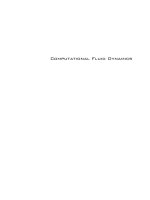Computational Fluid Dynamics Harasek Part 1 potx
Bạn đang xem bản rút gọn của tài liệu. Xem và tải ngay bản đầy đủ của tài liệu tại đây (1.96 MB, 30 trang )
Computational Fluid Dynamics
Computational Fluid Dynamics
Edited by
Hyoung Woo OH
Intech
IV
Published by Intech
Intech
Olajnica 19/2, 32000 Vukovar, Croatia
Abstracting and non-profit use of the material is permitted with credit to the source. Statements and
opinions expressed in the chapters are these of the individual contributors and not necessarily those of
the editors or publisher. No responsibility is accepted for the accuracy of information contained in the
published articles. Publisher assumes no responsibility liability for any damage or injury to persons or
property arising out of the use of any materials, instructions, methods or ideas contained inside. After
this work has been published by the Intech, authors have the right to republish it, in whole or part, in
any publication of which they are an author or editor, and the make other personal use of the work.
© 2010 Intech
Free online edition of this book you can find under www.sciyo.com
Additional copies can be obtained from:
First published January 2010
Printed in India
Technical Editor: Teodora Smiljanic
Computational Fluid Dynamics, Edited by Hyoung Woo OH
p. cm.
ISBN 978-953-7619-59-6
Preface
This book is intended to serve as a reference text for advanced scientists and research
engineers to solve a variety of fluid flow problems using computational fluid dynamics
(CFD). Each chapter arises from a collection of research papers and discussions contributed
by the practiced experts in the field of fluid mechanics. This material has encompassed a
wide range of CFD applications concerning computational scheme, turbulence modeling
and its simulation, multiphase flow modeling, unsteady-flow computation, and industrial
applications of CFD.
Editor
Hyoung Woo OH
Chungju National University
Korea
Contents
Preface V
1. Applications of CFD in Natural Gas Processing and Transportation 001
Majid Abedinzadegan Abdi, Esam Jassim,
Mohammad Haghighi and Yuri Muzychka
2. CFD Two Fluid Model for Adiabatic and Boiling Bubbly Flows in Ducts 029
Martin Lopez de Bertodano and Deoras Prabhudharwadkar
3. Contaminant Dispersion Within and Around Poultry Houses
Using Computational Fluid Dynamics
053
Sourabh R. Pawar, John M. Cimbala, Eileen F. Wheeler and Darla V. Lindberg
4. Investigation of Mixing in Shear Thinning Fluids
Using Computational Fluid Dynamics
077
Farhad Ein-Mozaffari and Simant R. Upreti
5. Turbulence, Vibrations, Noise and Fluid Instabilities. Practical Approach. 103
Dr. Carlos Gavilán Moreno
6. CFD-based Evaluation of Interfacial Flows 133
Kei Ito, Hiroyuki Ohshima, Takaaki Sakai and Tomoaki Kunugi
7. Numerical Simulation of Flow in Erlenmeyer Shaken Flask 157
Liu Tianzhong, Su Ge, Li Jing, Qi Xiangming and Zhan Xiaobei
8. Application of Computational Fluid Dynamics to the Study
of Designed Green Features for Sustainable Buildings
173
Cheuk Ming Mak
9. Unsteady Computational and Experimental Fluid Dynamics
Investigations of Aerodynamic Loads of Large Optical Telescopes
199
Mahmoud Mamou, Youssef Mébarki and Ali Tahi
VIII
10. Application of Computational Fluid Dynamics to Practical Design
and Performance Analysis of Turbomachinery
227
Hyoung Woo OH
11. Hydrodynamic Simulation of Cyclone Separators 241
Utikar, R., Darmawan, N., Tade, M., Li, Q, Evans, G., Glenny, M. and Pareek, V.
12. Prediction of Magnetite Segregation and Coal Partitioning In Dense
Medium Cyclone Using Computational Fluid Dynamics Technique
267
M. Narasimha, M. S. Brennan, P.N. Holtham and P.K. Banerjee
13. Modeling of Turbulent Flows and Boundary Layer 285
Dr. Srinivasa Rao .P
14. Computational Flow Modeling of
Multiphase Mechanically Agitated Reactors
307
Panneerselvam Ranganathan and Sivaraman Savithri
15. Computational Fluid Dynamics Methods for Gas Pipeline System Control 335
Vadim Seleznev
16. A Preconditioned Arbitrary Mach Number Scheme Applied
to Rotating Machinery
363
Chunhua Sheng
17. Modelling Hydrodynamic Drag in Swimming
using Computational Fluid Dynamics
391
Daniel A. Marinho, Tiago M. Barbosa, Per L. Kjendlie,
Narendra Mantripragada, João P. Vilas-Boas, Leandro Machado,
Francisco B. Alves, Abel I. Rouboa and António J. Silva
18. Hydrodynamic Behavior of Flow in a Drinking Water Treatment Clarifier 405
Wen-Jie Yang, Syuan-Jhih Wu, Yu-Hsuan Li, Hung-Chi Liao, Chia-Yi Yang, Keng-
Lin Shih and Rome-Ming Wu
1
Applications of CFD in Natural Gas
Processing and Transportation
Majid Abedinzadegan Abdi
1
, Esam Jassim,
Mohammad Haghighi and Yuri Muzychka
1
Memorial University of Newfoundland, St. John’s, Newfoundland and Labrador,
Canada
1. Introduction
In this chapter, two examples of CFD applications in natural gas processing and
transportation are presented. A commercial software package (Fluent) was used in these
studies. The purpose of the studies is briefly discussed, the methodology outlined and
boundary conditions and problem specifications are concisely described for each case. The
results of investigations and comparisons with experimental tests and literature data are
presented to demonstrate how CFD can be applied to practical situations.
2. Flow of real gas in supersonic nozzles
The demand for natural gas has encouraged the energy industry toward the discovery of
remote offshore reservoirs. Consequently new technologies have to be developed to
efficiently produce and transport natural gas to consumption centers. Common design
challenges in all gas processing methods for offshore applications are the compactness and
reliability of process equipment. Supersonic nozzles have been introduced as an alternative
to treat natural gas for offshore applications and to meet the offshore requirements
(Hengwei et al. 2005, Alfyorov et al. 2005, Okimoto et al., 2002, Karimi & Abedinzadegan
Abdi, 2006, Brouwer & Epsom, 2003). In a supersonic separator the gas temperature is
lowered based on the principle of gas expansion where no refrigerant is needed. The
compact design of supersonic nozzles is a major advantage over traditional means of natural
gas treating technologies particularly for offshore applications. The gas speed in this device
is very high preventing fouling or deposition of solids and ice. Refrigeration is self-induced
therefore no heat is transferred through the walls and unlike external refrigeration systems,
no inhibitor injection and inhibitor recovery system are necessary. Intensive water dew
points down to -50 to -60
o
C can be achieved without any cryogenic cooling or use of solid
adsorption techniques.
2.1 Problem description
Application of CFD technique is demonstrated to predict the behaviour of high pressure
natural gas flowing through supersonic nozzles. Supersonic nozzles were selected as it was
noticed that there was a potential for these nozzles for applications in natural gas processing
industries and very few simulation analysis had been published in the open literature. The
Computational Fluid Dynamics
2
nozzle considered here is a de Laval geometry composed of two sections: the convergent
section (subsonic zone) and the divergent section (supersonic zone). However, we also
address two other de Laval modified geometries, which are of interest in solid/liquid
particles separation; namely throat section (critical zone) with extended constant area throat,
and throat section with extended U-shape throat.
The function of the convergent part is to keep the flow uniform and parallel as well as to
accelerate the gas. Within the converging section leading to the throat area, the gas is
accelerated so that the sonic velocity is reached at the throat and the convergent curvature
keeps the gradient in velocity of the flow uniform. In practical conditions, in order to get the
sonic speed at the throat, it is required that the inlet diameter is kept larger than
5
of the
throat diameter (Man et al., 1997) although in some cases the ratio of inlet to throat diameter
is apparently less (Arina, 2004).
When the gas reaches the throat, the divergent part of the nozzle can further accelerate the
flow depending on the outlet condition. This results in a decrease in pressure and
temperature as well as increase in gas velocity. It is likely that under certain conditions the
flow cannot expand isentropically to the exit pressure; therefore, an irreversible
discontinuity, called a shockwave, can occur.
The shockwave is an abrupt disturbance that causes discontinuous and irreversible changes
in fluid properties, such as speed (changing from supersonic to subsonic), pressure,
temperature, and density. As a result of the gradients in temperature and velocity that are
created by the shock, heat is transferred and energy is dissipated within the gas. These
processes are thermodynamically irreversible. As the shock thickness is very small, the cross
sectional areas at the upstream and downstream of the shock are considered equal and the
energy or heat loss is negligible. The shock can also interact with the boundary layer and
this can delay the transition from supersonic flow to subsonic flow even further. The
increase of pressure across a shock is an indication of the shock strength that can lead to a
sound wave considered as a shockwave of minimum strength.
2.2 Basis of CFD simulation
The geometry was modeled using two-dimensional axisymmetric grids. The total pressure
and temperature for fully developed turbulent flow were imposed at the nozzle inlet, and
no-slip condition was applied at wall boundaries. At the exit plane, ambient pressure and
temperature were identified. CFD calculations were carried out using SIMPLEC algorithm
and the central differencing scheme.
For turbulent flow model, the k-ε model was used here due to its frequent use for industrial
applications, its relative accuracy, and its incorporation in most commercial CFD codes
(Pope, 2000).
2.3 Results and discussions
2.3.1 de Laval nozzles
Since most of published research has been concerned with the Laval nozzle, we validated
our results by applying the numerical technique for such geometry and compared our
results with the most recent available data (Arina, 2004; and Molleson & Stasenko, 2005)
before proceeding and applying it to the modified nozzle systems.
Molleson and Stasenko (2005) performed their investigation for a nozzle whose geometry is
shown in Figure 1-a. Their working fluid was methane at 70 bar inlet stagnation pressure
Applications of CFD in Natural Gas Processing and Transportation
3
and 250 K inlet stagnation temperature while the value of exit Mach number according to
their supersonic exit radii was 1.2. The SRK EOS model was used in their study. We used
the same geometry and conditions in comparison of the sonic condition and in studying of
the effect of a real gas model on the sonic position; MBWR was used as the thermodynamic
model.
Fig. 1. Nozzle geometries studied in the research
Figure 2 shows the variation of Mach number with position in real case and the comparison
with results obtained from the work of Molleson and Stasenko (2005). One can see that
choke (sonic velocity, M=1) occurs at the throat regardless of the EOS used. Also, our results
are in very good agreement with their results. The second comparison was performed to
Computational Fluid Dynamics
4
validate our simulation on capturing shockwave position. The comparison is done with
recent available data (Arina, 2004). The geometry used in the comparison, shown in Figure
1-b, is adopted from Arina’s work (2004). The working fluid was CO
2
. The dimensions of the
assumed Laval-nozzle are:
2
( ) 2.5 3 1.5
th th
xx
Ax
xx
⎛⎞⎛⎞
=+ −
⎜⎟⎜⎟
⎝⎠⎝⎠
for
th
xx
≤
, (1)
2
( ) 3.5 6 4.5
th th th
xxx
Ax
xxx
⎛⎞
⎛⎞
⎜⎟
=− − +
⎜⎟
⎜⎟
⎝⎠
⎝⎠
for
th
xx≥ . (2)
Where, A
throat
= 1 cm
2
, length= 10 cm and the throat placed at x
th
= 5 cm.
0 0.1 0.2 0.3
x/L
t
0.2
0.4
0.6
0.8
1
1.2
Mach Number
This Study
Molleson et al. (2005)
Fig. 2. Comparison of Mach numbers upstream of choke region in the Laval nozzle
Since Arina’s simulation was performed near CO
2
condensation conditions, for which T=
1.001T
c
and
ρ
=
ρ
c
, we compared our results for a perfect gas case as the FLUENT real gas
basis could not predict multiphase conditions. The exit pressure was 83% of the inlet
pressure. Our numerical results displayed the same behaviour when similar conditions and
working fluids were applied as seen in Figure 3.
2.3.1.1 Real gas vs. Ideal gas assumption
The significance of using real gas models can be more clearly shown when comparison of the
location of the shockwave within the Laval nozzle is made for two different gases: methane
and nitrogen. At high pressures, the former compressibility factor significantly changes
whereas the compressibility for the latter has almost the equivalent value of perfect gases.
Applications of CFD in Natural Gas Processing and Transportation
5
0 0.2 0.4 0.6 0.8 1
x/L
t
0.2
0.4
0.6
0.8
1
ρ
r
/
ρ
I
CO
2
(Perfect Gas)
Arina (2004)
This Study
Fig. 3. Comparison of density ratios in the Laval nozzle under perfect gas conditions
2.3.1.2 Shockwave location
The real gas model predicts the shockwave location earlier than the ideal gas model for both
gases. However, the differential distance between the ideal and real shock positions is
different. In fact, when the ideal gas model is used, shock occurs earlier for nitrogen, see
Figure 4-a. On the contrary, the real gas model predicts an opposite behaviour as shown in
Figure 4-b. This example proves very clearly that ignoring the real gas effects can obviously
lead to misleading results.
2.3.1.3 Real gas effects for a different configuration
The new configuration of the nozzle system designed for natural gas application consists of
three different parts: an inlet nozzle (converging part ending to a throat and a slight
expansion), diffuser (diverging part, gas final expansion and exit), and a conduit with
constant area between these two parts. This latter part does not exist in conventional Laval
nozzles where the diffuser or diverging part starts right after the throat and continues
uniformly right up to the exit point. The description of the new system is shown in Figure
1-c.
Boundary conditions were chosen in such a way that the inlet pressure was predicted.
Hence, we chose mass flow rate and temperature as the inlet boundary conditions while
pressure and temperature were chosen for outlet boundary conditions. The working fluid
was pure methane, mass flow rate was 430 kg/minute, stagnation temperature at the inlet
and outlet were 293 and 280 K, respectively and the stagnation pressure at the outlet was
assumed 7 MPa. The stagnation pressure at the inlet was to be predicted. The results of
simulation are discussed as follows:
Computational Fluid Dynamics
6
0 0.2 0.4 0.6 0.8 1
x/L
t
0
0.4
0.8
1.2
1.6
2
Mach Number
Ideal
N
2
CH
4
(a)
0 0.2 0.4 0.6 0.8 1
x/L
t
0
0.4
0.8
1.2
1.6
2
Mach Number
Real
N
2
CH
4
(b)
Fig. 4. Comparison of shock position for nitrogen and methane under (a) ideal and (b) real
gas conditions
Applications of CFD in Natural Gas Processing and Transportation
7
Density. By looking at any fluid textbook, one can see that the conservation of momentum
equation directly or indirectly contains density terms in each component. Thus, flow
structure is severely affected by any deviation in density calculation. To realize how this
deviation will affect the predictions in the nozzle, a graph of the density ratio (real/ideal)
along the nozzle system is plotted (see Figure 5). It is evident how erroneous the results
might get if the perfect gas model is used, particularly in the vicinity of the shockwave. A
large spike of density variations is seen close to the shockwave.
0 0.2 0.4 0.6 0.8 1
x /L
t
1
1.2
1.4
1.6
1.8
2
2.2
2.4
2.6
2.8
3
ρ
r
/
ρ
i
Fig. 5. Centerline density ratio for real gas (methane) simulation in an extended throat nozzle
Inlet Pressure. As mentioned earlier, our numerical solution predicts the inlet pressure for
the given mass flow rate, outlet pressure and outlet temperature. Figure 6 represents static
pressure distribution at the axis. One can see that a significant difference between the real
and perfect gas at the inlet pressure is obtained. The real gas model predicts lower required
inlet pressure for a given mass flow rate. Thus, better pressure recovery may be obtained.
The real gas simulation predicts pressure recoveries in excess of 10% over those predicted
by the perfect gas model. Also, the difference between real and ideal static pressures forces
the calculation of total pressure to diverge. The errors in evaluating the total pressure and
temperature can lead to incorrect predictions for friction loss, work and heat transfer. The
differences between the predictions of ideal and real gas models for total pressure and total
temperature are considerable. These discrepancies can result in incorrect values for friction
losses and other calculated parameters.
Temperature. Static temperature decreases during the isentropic expansion process. Figure
7 illustrates the longitudinal variation of static temperature along the insulated wall. It is
clearly shown that the temperature reduction in the real gas case is larger than the ideal
case. Thus, ideal gas simulation can lead to erroneous results in predicting the potential
phase change.
Computational Fluid Dynamics
8
0 0.2 0.4 0.6 0.8 1
x/L
t
0
2
4
6
8
10
12
Static Pressure (Mpa)
Real
Ideal
Fig. 6. Centerline static pressure for real gas (methane) simulation in an extended throat
nozzle
0 0.2 0.4 0.6 0.8 1
x/L
t
240
250
260
270
280
290
300
Static Temperature (K)
T
s
Real
Ideal
Fig. 7. Wall static temperature distribution for real gas (methane) simulation in an extended
throat nozzle
Applications of CFD in Natural Gas Processing and Transportation
9
Theoretically, stagnation temperature should retain its value across the shock when the
nozzle is insulated. Such conclusion is true when perfect gas law is used as the
thermodynamic model. However, the real gas model predicts different conditions in which
the stagnation temperature may vary. Stagnation temperature in the real gas case varies
across the shock because the specific heat is now varied across the shock as well. Thus, for
adiabatic process;
02
01
00
(). 0
T
T
Cp T dT
=
∫
(3)
This means that
02 01
TT
≠
across the shockwave.
As a conclusion of modelling of supersonic nozzles using real gas models and discussion of
the effect of real gas on the flow of natural gas through these nozzles, the choice of
thermodynamic model can substantially affect the modelling results. This includes the
position of shockwave, the fluid properties and conditions after the shock, and the
work/heat transferred across the system.
2.3.2 de Laval nozzles with extended straight throat
In this section the influence of geometry on the flow of natural gas through the supersonic
nozzle is presented. As mentioned in Section 2.3.1, the nozzle is composed of three sections:
the convergent section (subsonic zone), the extended throat section (critical zone) and the
divergent section (supersonic zone).
The governing equations are derived from the basic conservation laws including mass
(continuity), momentum, and the first and second laws of thermodynamics and the use of a
quite suitable real gas Equation of State (EOS).
2.3.2.1 Geometry Influence
Choke location: The flow reaches sonic condition at the throat, expands in the slight
diverging/expansion section of the nozzle (~ 0.04 m), passes through the constant cross-
section area, and finally moves across the diffuser within which the shock occurs. The flow
downstream of the shock is subsonic. Thus a pressure recovery occurs. The base Fluent
simulation cannot predict any phase change therefore it is assumed that no condensation
will occur as the gas passes through the nozzle. Gas dynamics parameters for real and ideal
flow are presented in Figures 8. The Figure indicates that no sensible variation is predicted
in longitudinal Mach number, especially in the inlet/converging part. The vertical line x=x*
confirms that, for both cases, the Mach number value of unity is obtained at the critical cross
section of the nozzle. This conclusion agreed very well with the predictions in recent studies
(Arina, 2004, Molleson & Stasenko, 2005, and Drikakis & Tsangaris, 1993). It can, therefore,
be concluded that the sonic position always occurs at the throat and is independent of the
nozzle geometry and gas thermodynamic model.
Shock position: A shock wave occurs in the diffuser part of the system that leads to a
change in the flow from supersonic to subsonic. The real gas model predicts the shock
location earlier as concluded in Section 2.3.1. Arina (2004) compared several real gas EOS
with the corresponding perfect gas model. He concluded that all the real gas models predict
a similar flow in the convergent part, while the shock position is slightly varying from one
model to another. However, his conclusion was built on a Laval nozzle and inert gases (air)
which behave almost ideally even at high pressures. It can also be concluded that
Computational Fluid Dynamics
10
0 0.2 0.4 0.6 0.8 1
x/L
t
0
0.4
0.8
1.2
1.6
2
Centre Mach Number
M
c
Real
Ideal
Fig. 8. Centerline Mach number for real vs. ideal methane simulation in an extended throat
nozzle
-120 -80 -40 0 40
Temperature (c)
0
4
8
12
2
6
10
Pressure (Mpa)
L=0
L=5d
t
L=8.5
d
t
Epsom (2005)
Fig. 9. Pressure-temperature chart for real gas (methane) simulation in an extended throat
nozzle
x=x
*
Applications of CFD in Natural Gas Processing and Transportation
11
thermodynamic models and the system’s geometry play the most significant roles in
predicting the shock position. Hence, the more accurate EOS would result in a closer
prediction of the shock location and behaviour.
Length of Constant Cross Section Area Conduit: In order to separate liquid particles from
natural gas and place instruments to control the shock wave location, Twister Inc. (Epsom,
2005) uses an extended constant area throat within the area just before the diffuser section of
the Laval nozzle. Although the exact dimension and geometry of the Twister’s nozzle are
unknown, we studied the effect of the length of the constant cross section area conduit by
selecting several length-to-diameter (L/d
t
) ratios. The results of the simulation are plotted on
a Pressure-Temperature (P-T) chart as shown in Figure 9. We could produce the same P-T
chart as the Twister (Epsom, 2005) by changing the length of the conduit part by adjusting
the (L/d
t
) parameter. This indicates that, in addition to the nozzle outlet pressure, by
adjusting the channel length, the minimum temperature of the system and shock position
can be controlled.
Mesh generation
The quality of the mesh plays a significant role in the accuracy and stability of the numerical
computation. The issue of grid quality is concerned with the ability of a particular
discretization scheme to accurately represent the continuous governing equations on a given
grid. The final accuracy and efficiency of any numerical solution are highly dependent on
the particular meshing strategies and the mesh density distribution employed. The key to an
efficient overall numerical solution remains in a good matching of the strengths and
weaknesses of the grid generation and flow solution techniques and the maintaining of a
strong and favourable interplay between these two phases of the solution procedure.
Obviously, the goal of any numerical simulation should be the optimization of both the
discretization scheme as well as the grid generation scheme.
Although accuracy increases with finer grids, the CPU and memory requirements to
compute the solution and post-process the results also increase. Of many solutions to such
deficiency -adaptive grid refinement can be used to increase and/or decrease grid density
based on the evolving flow field, and thus provides the potential for more economical use of
grid points and hence reduced time and resource requirements. Multigrid strategy also
represents another recent powerful technique which takes a more comprehensive approach
to the general problem of numerically simulating a physical phenomenon by closely
coupling the grid generation and numerical solution aspects. The idea of a Multigrid
algorithm, which was considered in the present numerical technique, is to accelerate the
convergence of a set of fine-grid discrete equations by computing corrections to these
equations on a coarser grid (Peyret, 1996), where the computation can be performed more
economically. This process is applied recursively to an entire set of coarse-grid levels. Each
Multigrid cycle begins on the finest grid level and cycles through the various levels up to the
coarsest mesh. At this stage the computed corrections are successively interpolated back to
the finest level and the cycle is repeated. The accuracy of the final discretization is solely
determined by the fine-grid discretization, and the coarser levels may be viewed simply as
artefacts employed to accelerate convergence.
The dependence of the accuracy on the quality of the grid can be reduced if more grid
metric information is included. However, grid dependency studies (Drikakis & Tsangaris,
1993) have shown that finer meshes do not necessarily influence the accuracy of the solution
in the case of the axisymmetric nozzle flow. This conclusion was also reached in our
Computational Fluid Dynamics
12
simulation when three different numbers of mesh cells, 1882, 5533 and 11 832 cells, were
selected. Table 1 shows the number of iterations that led to convergence with respect to total
mass error in inlet/outlet mass flow for each case. It is clearly shown that finer grid did not
significantly affect the iteration steps for convergence. In fact, for coarser grids (i.e. 1882
cell), convergence occurred even faster (~1500 steps). However the position of shock
changed and became stabilized after the number of iterations was doubled. The uncertainty
of shock spot forces us to choose finer grids, especially since the shock wave is considered as
one of the large gradient regions that requires grids to be fine enough to minimize the
change in the flow variables from cell to cell. Due to the difficulties in determining the
location of the shock in advance, one should strive to achieve a high-quality mesh over the
entire flow domain. Hence, we considered 5533 grid cells as the computational mesh for the
present study to endorse smooth variations of flow properties across shock region.
Convergence occurred after a certain number of iteration steps and varied for real and ideal
gas models. For example convergence for real gas non-swirl case occurred after 3182
iterations with an error in inlet/outlet mass flow of about 4.8x10
-4
%. Table 2 shows the
number of iterations that led to convergence with residual errors for continuity, energy, k
and
ε
equations for non-swirl real and ideal cases.
No. of Cells No. of Iterations % errors in mass flow
1 882
5 533
11 832
3 030
3 182
3 500
9.8×10
-3
4.8×10
-4
3.2×10
-1
Table 1. Number of iterations that led to convergence for simulation cases with total mass
error in inlet and outlet mass flow
Case
% Error of
Inlet/Outlet Mass
Balance
Number of
Iteration Steps
Continuity Energy
k
ε
Ideal
Real
2.0×10
-4
4.8×10
-4
9 230
3 182
2.40×10
-3
5.85×10
-4
1.90×10
-3
5.58×10
-4
8.50×10
-6
5.58×10
-5
9.60×10
-6
6.03×10
-5
Table 2. Number of iterations that led to convergence with residual errors for continuity,
energy, k and
ε
equations for non-swirl real and ideal cases
2.3.3 de Laval nozzles with extended U-shape throat
The purpose of this section is to find alternative designs to the swirling flow of gas through
the Laval nozzle configuration that was discussed earlier in search of better separation
performances. As a result, the Laval nozzle with extended U-shaped section was proposed.
The proposed nozzle is composed of three sections:
1. The convergent subsonic section that experiences a slight divergence after the throat to
accommodate for the supersonic flow of the gas.
2. The U-shaped extended throat through which the centrifugal force exerted on the
particles is expected to provide the intended separation between phases (gas-liquid,
gas-solid, or gas-solid-liquid).
3. The divergent section that provides the cross-sectional growth required for pressure
recovery.
Applications of CFD in Natural Gas Processing and Transportation
13
The design parameters in this study included the ratio of the inside diameter of the throat to
that of the U-shaped section, the curvature radius of the U-shaped section, and the inlet and
outlet pressures. System variables that were used in the analysis were position of the shock,
gas velocity inside the U-shaped section, and consequently the centrifugal acceleration
experienced by the gas flowing inside that section used as a measurement of the level of
phase separation the device could deliver.
Simulations were based on the inviscid flow of methane as process fluid. The governing
equations were those of the conservation laws (mass, momentum, and energy) along with
an appropriate thermodynamic model to predict gas properties.
As no experimental results are available for evaluation purposes, a pilot test is under
development that uses compressed air as process fluid. The test results will then be
compared to those of the CFD simulations performed under the same conditions to evaluate
the computer models.
2.3.3.1 Throat diameter ratio
As it was shown in the previous section, the flow always reaches sonic velocity at the throat.
The slight divergence after the throat and before the U-shaped section is to allow the flow to
reach supersonic velocity. Assuming pressure drop across the nozzle is large enough, the
value of the Mach number at the entrance to the U-shaped section depends solely on the
ratio of the diameter at this point to that of the throat. Since the purpose of the U-shaped
section is to take advantage of the supersonic flow in a circular path, it is important that the
shock takes place in the diverging section. It must be noted that despite the diameter of the
nozzle is constant throughout the U-shaped section, a shock wave may take place inside that
section due to the loss of energy in the U-shaped section.
The U-shaped section to throat diameter ratio of 1.2 was determined to be most effective in
this study. This means that the constant cross-section area of the U-shaped section has a
diameter of 1.2 times the diameter of the throat where the choke takes place. It is important
to realize that this ratio is not the only factor that determines the position of the shock. Other
parameters involved are the U-shaped section curvature radius and outlet back pressure.
2.3.3.2 U-shaped section curvature radius
The curvature radius of the U-shaped section has two converse effects on the flow.
Increasing the radius of the curvature allows the gas to pass through it with faster velocity
and higher Mach number without triggering a shock wave, but at the same time reduces the
centrifugal acceleration (Bird, 1924). This is easily shown by the kinematic expression of
tangential acceleration:
2
tangential
V
a
r
=
(4)
It may be concluded that since velocity is raised to the power of two in this equation, its
value overweighs the negative value of increased radius. It should be noted though that an
important feature of such supersonic separators is their relatively small size, and a rather
large radius of curvature will compromise this characteristic. After vigilant study of several
designs with various curvature radii, it was determined that a U-shaped section with a
decreasing radius profile would be the best configuration for this design. The curvature
profile shown in Figure 10 was therefore developed for the U-shaped section of the nozzle.
Computational Fluid Dynamics
14
The radius of this profile is 40 units in the beginning (lower left section) and decreases
continuously until it reaches 5 units in the end (upper section).
Fig. 10. A typical variable curvature proposed for the U-shaped section of the Laval nozzle.
2.3.3.3 Inlet pressure/Outlet back pressure
The outlet back pressure in this study was chosen to be the atmospheric pressure. The inlet
pressure as well as the flow rate of the gas through the device were hence the other
parameters affecting the pressure drop through the nozzle and consequently the position of
the shock wave.
2.3.3.4 Particle Separation
Particle separation, as it was mentioned before, is due to the centrifugal force that is exerted
on the flow as it passes through the U-shaped section with high velocity. The particles (e.g.
micron size liquid droplets) are forced towards the outermost wall in the U-shaped section
and may be extracted via a side channel that is installed in an appropriate position. Figure11
shows the values of centrifugal acceleration along this section as it is experienced by the
flow. The acceleration is calculated from Equation (4). The graph is generated from the CFD
simulation results for the geometry shown in Figure 12 when an inlet pressure of 345 kPa
(50 psia) was imposed. It can be seen in the graph that the particles experience centrifugal
accelerations of up to 36,000,000 m/s
2
in this particular configuration. That is the equivalent
of approximately 3.7 million g.
2.3.3.5 Shockwave position
The position of the shockwave is very important for the performance of such separators. The
shockwave should not take place before or through the U-shaped section as it was explained
before. It is also important that the shock does not occur too far into the diverging section.
This is because the farther into this section the shock takes place, it requires more
differential pressure driving force across the device and therefore results in a greater
pressure loss. It is crucial that the shock occurs as early as possible in the diverging section.
Applications of CFD in Natural Gas Processing and Transportation
15
Fig. 11. Variation of centrifugal acceleration as a function of position along the U-shaped
section in the proposed Laval nozzle.
Fig. 12. A typical design configuration of the proposed Laval nozzle.
This property is one of the properties that were used to adjust the design and operating
conditions of the separator. The position of the shockwave can be monitored through many
different methods such as pressure profiling and velocity profiling. The most effective and
accurate method that became available through the CFD package’s post processing
capabilities was the use of Mach number contours across the device. Theses contours clearly
show the position of the shockwave as well as its shape and intensity (see Figure 13).
Computational Fluid Dynamics
16
Fig. 13. Mach number filled contours showing the position of the shock wave.
2.3.3.6 Separation channel position
One important design parameter is to determine where the side channel to separate the flow
of particles from the main gas flow should be placed. This can also be easily determined
using the post processing features of the CFD package. Figure 14 is a volume density
contour, precisely showing where most of the higher density particles are accumulated
along the U-shaped section.
2.3.3.7 Mesh Generation
As it was mentioned previously, the quality of the mesh is a key factor in the accuracy and
stability of a numerical (finite volume) analysis. Various characteristic properties of the
geometry itself, types of fluids involved, and the amount of available memory and
processing capability are some of the parameters that contribute to the final selection of a
specific mesh design. A combination of wedge shaped and tetrahedral elements was chosen
to represent the geometry in Figure 12. The geometry was divided into 6 sections as it can be
seen in Figure 15. All sections were meshed using wedge shaped elements except section 2
which was meshed using tetrahedral elements due to the high gradient of cross-sectional
area. Section 1 is only a simple pipe and its purpose is to stabilize the flow of gas before it
enters the nozzle system. The meshing of this section therefore does not require a very fine
quality. The mesh elements in this section are wedges with a length of 5.08×10
-3
m (0.2”) and
Applications of CFD in Natural Gas Processing and Transportation
17
Fig. 14. A typical contour of the particles volume density showing where a side channel
should be positioned to separate most of the particles
Fig. 15. Geometry divisions for meshing purposes.
equilateral triangular bases with edges of 2.54×10
-3
m (0.1”) (see Figure 16). Section 2 is the
converging section of the nozzle and is meshed with a shrinking tetrahedral scheme
(Figures 17 and 18). This method ensures the stability of the geometry through the









